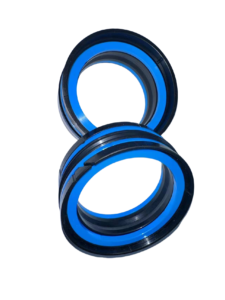Table of Contents
ToggleWhat is the Difference Between a Buffer Seal and a Rod Seal?
Rod seals and buffer seals are critical yet distinct components in hydraulic cylinder sealing systems. While they work synergistically, their roles, designs, and operational priorities differ significantly. This article breaks down their differences in function, placement, materials, and applications to clarify their unique contributions to hydraulic performance.




Core Definitions
1. Rod Seal
Primary Role:
Rod seals (also called gland or neck seals) are the primary dynamic seals mounted around the piston rod at the cylinder head. Their key functions include:
- Preventing high-pressure hydraulic fluid from escaping during rod movement.
- Blocking external contaminants (e.g., dirt, moisture) from entering the cylinder.
- Maintaining steady system pressure under both static and dynamic conditions.
Design & Materials:
- Constructed for low friction and wear resistance during continuous motion.
- Common materials: Polyurethane (abrasion resistance), rubber (elasticity), or PTFE (high-temperature/chemical compatibility).
- May include anti-extrusion backup rings (e.g., thermoplastic) for high-pressure applications.
Failure Impact:
Direct failure results in visible fluid leaks and compromised system integrity.
2. Buffer Seal
Primary Role:
Buffer seals (sometimes termed shock or damping seals) serve as secondary protective seals positioned upstream of rod seals. Their objectives are:
- Absorbing pressure spikes and vibrations, particularly at the end of cylinder strokes.
- Shielding rod seals from sudden overloading, extrusion, and mechanical impact.
- Reducing heat generation and friction on the rod seal.
Design & Materials:
- Engineered for energy absorption and controlled leakage.
- Materials: Often softer elastomers (e.g., polyurethane) or PTFE with reinforced lips.
- May incorporate O-ring energizers, variable orifices, or backup rings for damping precision.
Failure Impact:
Degradation leads to accelerated rod seal wear and exposure to pressure extremes.
Key Differences at a Glance
| Aspect | Rod Seal | Buffer Seal |
| Primary Role | Prevents fluid leakage and contamination. | Protects rod seals from pressure spikes and mechanical shock. |
| Location | Outermost gland area (where the rod exits the cylinder). | Positioned between the rod seal and piston/wiper in the gland assembly. |
| Pressure Handling | Maintains sealing under steady operating pressure. | Withstands transient pressure peaks and end-of-stroke shocks. |
| Material Focus | Low-friction polymers (e.g., polyurethane) for dynamic efficiency. | Reinforced materials optimized for energy absorption. |
| Failure Consequence | Immediate fluid leakage. | Increased rod seal wear and system vulnerability to pressure extremes. |
Design & Material Nuances
Rod Seals
- Prioritize dynamic sealing efficiency across millions of pressure cycles.
- Common profiles: Single-lip (unidirectional) or double-lip (bidirectional) designs.
- Advanced variants: Spring-loaded tips (e.g., Resilon®) for zero-leakage performance in precision applications.
Buffer Seals
- Focus on damping transient forces through specialized geometries:
- Variable orifices to dissipate energy during shock events.
- Lip seals with backup rings to prevent extrusion under extreme loads.
- Material selection balances flexibility (for damping) and hardness (for abrasion resistance).
Operational Synergy
Together, rod and buffer seals form a tandem sealing system:
- The rod seal acts as the frontline barrier against leaks and contaminants.
- The buffer seal extends the rod seal’s lifespan by:
- Mitigating pressure spikes during heavy loads or abrupt stops.
- Scraping contaminants off the rod during retraction (in some designs).
- Reducing thermal stress on the rod seal by absorbing friction-generated heat.
This synergy ensures hydraulic cylinders achieve long-term durability in demanding environments like mining or construction.
Application-Specific Considerations
When to Use Buffer Seals
- Heavy-Duty Mobile Equipment: Excavators, mining machinery, and forestry equipment require buffer seals to handle high-frequency shocks and abrasive conditions.
- High-Pressure Systems: Applications with rapid pressure fluctuations (e.g., industrial presses) benefit from buffer seals to prevent rod seal extrusion.
When Rod Seals Suffice
- Low-Shock Environments: Systems with steady pressure profiles (e.g., assembly line actuators) may rely solely on rod seals.
- Precision Applications: Where minimal friction is critical (e.g., robotics), optimized rod seals may operate without buffers.
Maintenance & Selection Guidelines
- Inspection:
- Monitor buffer seals for lip deformation post heavy-shock cycles.
- Rod seal wear often signals inadequate buffering or misalignment.
- Material Compatibility:
- Match seal materials to hydraulic fluid type (e.g., petroleum-based vs. synthetic).
- Avoid elastomers prone to hardening/swelling in extreme temperatures.
- Installation Precision:
- Ensure proper groove dimensions and lubrication for buffer seals to achieve intended damping.
- Multi-stage buffering (stacked seals) may be needed for extreme shock absorption.
- System Tuning:
- Pair rod seals with anti-extrusion rings in high-pressure systems.
- Adjust orifice designs in buffer seals for optimal energy dispersion.
Conclusion
The distinction between buffer seals and rod seals lies in their hierarchical roles:
- Rod seals are indispensable for maintaining hydraulic pressure integrity.
- Buffer seals are the unsung heroes that enhance system resilience by absorbing operational stresses.
Understanding these differences enables engineers to design cylinders that balance sealing efficiency, durability, and cost-effectiveness across diverse applications. By prioritizing their unique requirements—whether for steady pressure management or shock absorption—you can optimize hydraulic performance in even the most challenging environments.



Leave A Comment